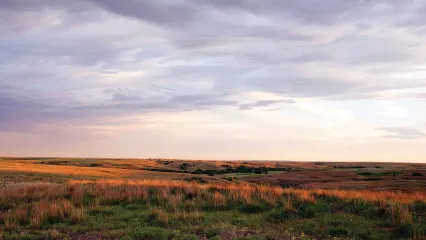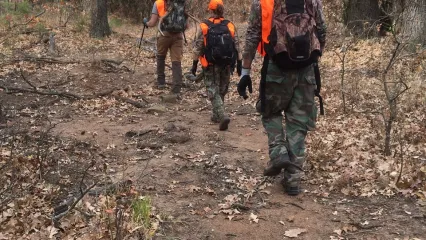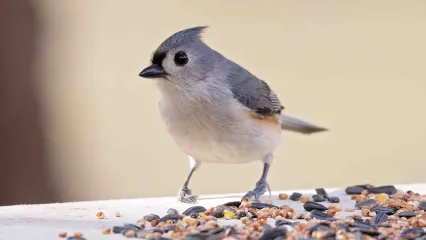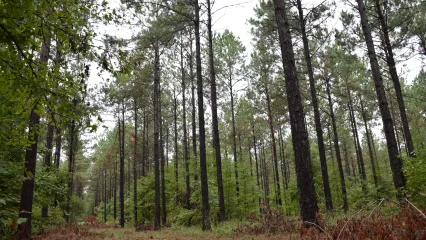Attention Non-Residents
The Oklahoma Wildlife Conservation Commission adopted new rules in 2025 that require non-residents accessing certain Oklahoma public hunting and fishing areas to check in and out of the area. By checking in and out of these areas, hunters, anglers, shooters, birdwatchers, hikers and any other users can help the Wildlife Department better understand how the area is being used. There is no additional cost associated with checking in or out of an area. There is no limit to the number of check ins for an individual in a year.

Contacts
Area Details
Cimarron Hills WMA covers 4,200 acres in western Woods County, located four miles north of the junction of Highways 34 and US 64, and then four miles west on Major road. The area lies north of the city of Woodward, east of Buffalo, and west of Alva. Cimarron Hills WMA is primarily rolling sand hills overlooking the east side of the Cimarron River. The area is dominated by mixed-grass prairie vegetation and sand sagebrush and sand plum on the uplands and vegetated by tall grass prairie species in the river bottom along with cottonwood, hackberry, and western soapberry trees along West Anderson Creek. A limited amount of Cimarron River flood plain exists along the west boundary of the WMA, dominated by salt flats, interspersed with some salt cedar.
All hunting activities will be by walk-in only. Consult regulations before entering the area.
Going Quail Hunting?
During quail hunting season, wing collection boxes are placed at several wildlife management areas: Beaver River, Optima, Packsaddle, Cooper, Kaw, Drummond Flats, Canton, Fort Supply, Cross Timbers, and Pushmataha. Hunters are asked to donate a wing from each quail they harvest for research purposes. Ultimately, the wings can help determine the status of the quail populations at the WMAs and can offer clues about how next year’s season might pan out.
From Buffalo: 19 miles east on U.S. Hwy 64, 6 miles north on State Hwy 34, 2½ miles west on Major Road.
- Quail: Bobwhite quail are present in moderate numbers.
- Deer: White-tailed deer are present in limited numbers, mule deer are rarely seen.
- Turkey: Rio Grande turkeys are present in very low numbers.
- Pheasant: Pheasants are extremely rare.
- Dove: Dove are present in fair numbers.
- Rabbit: Rabbits are present in fair numbers.
- Waterfowl: Duck and goose opportunities exist along the river.
- Furbearers: Coyote, bobcat and raccoon are present.
- Lesser Prairie Chicken, Bell’s Vireo, Eastern Collard Lizard, Texas Horned Lizard, Western Diamondback and Prairie Rattlesnakes, loggerhead shrike, western big-eared bat, Cassin Sparrow, Grasshopper Sparrow, Red Headed Woodpecker, red-tailed hawk, Snowy Plover, and Interior Least Tern.
All activities will be by walk-in only, and will be restricted during hunting seasons and by on-going management practices. Consult regulations before entering the area.
Cimarron Hills management practices will include prescribed grazing by livestock, strip mowing, pasture aeration, prescribed burning, and selective removal of upland trees. These techniques will produce native wildlife foods that will include ragweed, croton, and sunflowers.
The WMA has one primitive camping area, located to the northwest of the headquarters. Other accommodations can be found in Woodward, 35 miles south on Highway 34 or in Buffalo, 20 miles to the west on US Highway 64, or 38 miles east to Alva.
Limited along river. Fishing will be accessible by walk-in only.
Closed Seasons
Same As Statewide Seasons
Seasons w/ Special Restrictions
- Dove, Rail, Gallinule
Closed during deer muzzleloader season.
- Pheasant
Closed during the first nine days of deer gun season. Hunting hours close at 4:30 p.m. daily.
- Squirrel, Rabbit, Crow, Snipe, Woodcock, Pursuit with Hounds for Furbearers, Predator/Furbearer Calling, Duck, Merganser and Coot
Same as statewide season dates, except closed the first nine days of deer gun season.
- Turkey Fall Gun
Same as statewide season dates. Shotgun only.
- Trapping
Open to water sets, live box traps and enclosed trigger traps only through Jan 31. Open same as statewide Feb 1 through end of February.
- Turkey Spring, Youth Turkey Spring
One-tom limit; seasons combined. Hunting hours close at 7:00 p.m. daily.
- Quail
Closed during the first nine days of deer gun season. Hunting hours close at 4:30 p.m. daily. Closed to non-resident hunting Feb 1-15.
Hunter and angler camping is allowed in designated areas.
Apprentice Designation: A Learner's Permit for Hunting
Hunter education has greatly reduced hunting accidents, but if you can’t complete a course right away, the apprentice designation allows you to hunt under supervision. It works like a learner’s permit, giving you the chance to gain real experience safely until you finish hunter education.
Exploring the New Herron Family WMA
The new Herron Family WMA is more than 17,000 acres of hunting land, it is also adventure, access, conservation, and tradition. Thanks to a unique partnership, Oklahoma residents now have a new place to chase deer, call turkeys, hear quail, and pass on the outdoors to the next generation.


